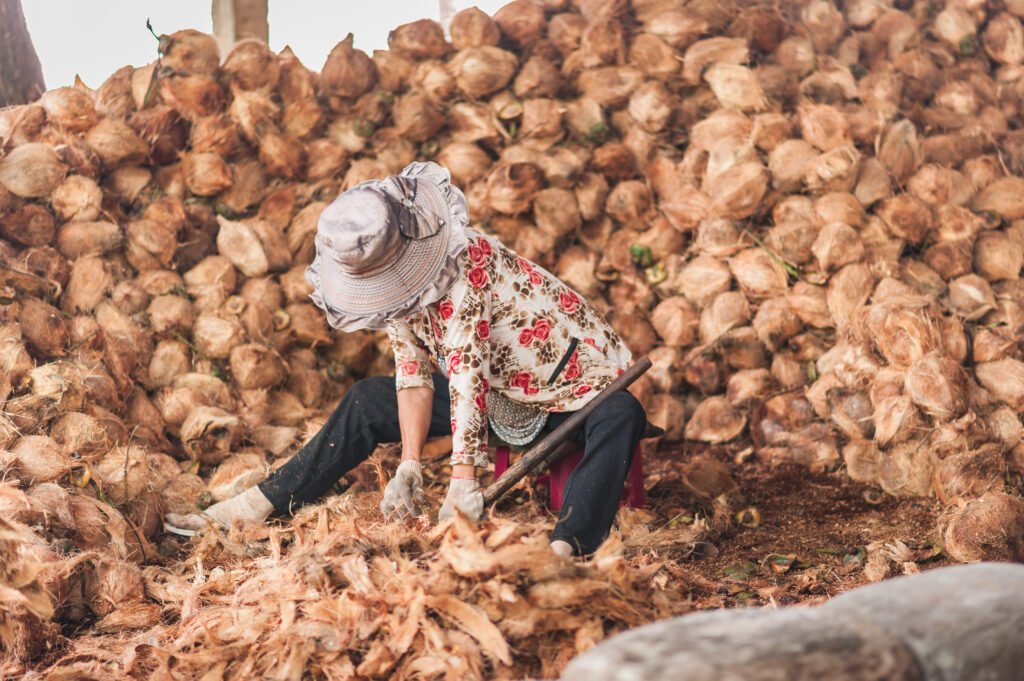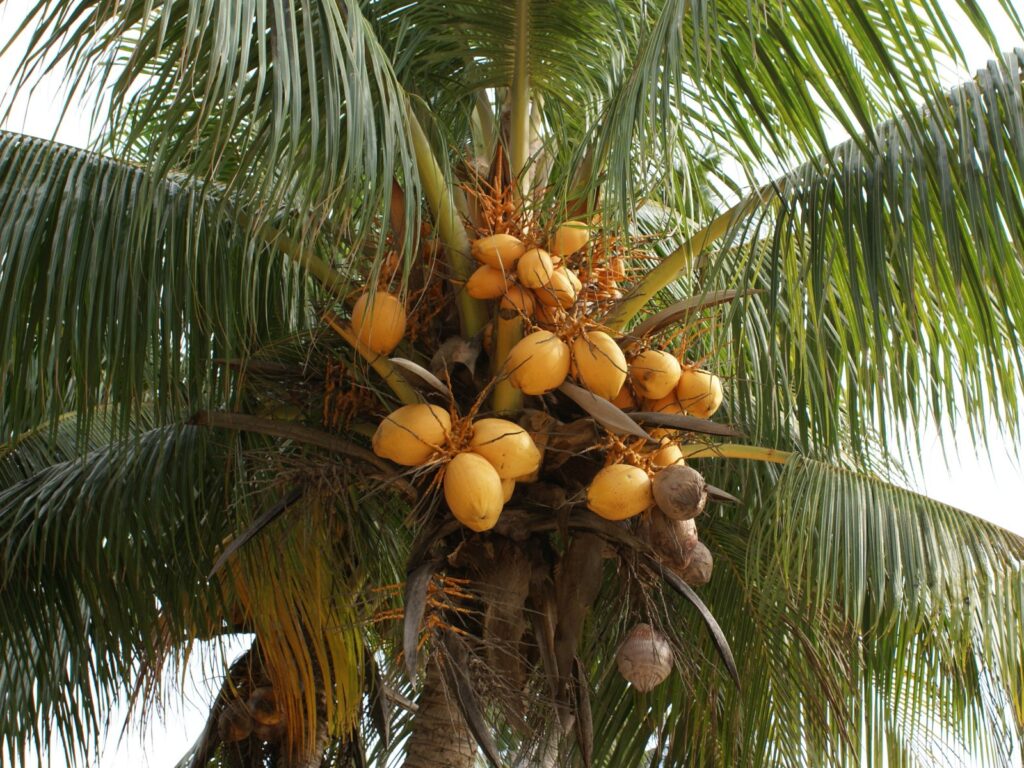Coconut is a typical tropical woody oil crop, a monocotyledonous perennial evergreen tree of the palm family Palmariaceae, a well-known cash crop and landscape plant in tropical China. The soft coconut water contains high levels of vitamin b, vitamin c, minerals and 18 essential amino acids, ideal for cooling drinking water – the flesh of the coconut can be eaten raw. In addition, secondary processing can be carried out to make coconut milk, coconut oil, coconut and coconut paste. Coconut cultivation is mainly distributed within 20 sides of the equator and between 20 and 23.5 north and south latitudes. Coconut is currently grown in more than 90 countries around the world, with the Philippines, Indonesia, India and Malaysia being the main origins.
In recent years, with the increase in demand for coconut products, the scale of coconut cultivation has also expanded, and a large amount of waste is produced along with the cultivation and processing of coconut production. These wastes are discarded or directly burned, which not only pollutes the ecological environment, but also wastes a lot of resources, which is not conducive to the implementation of China’s sustainable development strategy. Therefore, it is important to understand and grasp the current situation of research on the comprehensive utilization of coconut waste and the extent of its utilization, and to analyze its main problems, in order to study and promote the development of comprehensive utilization technology of coconut waste in China.

1 The cultivation status of coconut and its waste resources in China
1.1 Cultivation of coconut
Coconut cultivation in China has a history of 2,000 years, and the main cultivation areas are concentrated in Hainan Province, where coconut production accounts for more than 90% of the national total. Other areas such as Shangchuan and Hachuan Islands in Guangdong, Xishuangbanna Dai Autonomous Prefecture in Yunnan, Yao Qinzhou in Guangxi and southern Taiwan have a small amount of cultivation. In 2010, China’s coconut cultivation area was about 40.37 million hm2, with a total national output of about 250 million coconuts, including 39.16 million hm2 of coconuts in Hainan Province, with an output of 230 million. In recent years, with the improvement of people’s living standard and the development of tourism, the demand for coconut and its products has increased, and the wasteland suitable for coconut cultivation in China has been developed and utilized.
1.2 Coconut waste resources
Coconut waste refers to the by-products of coconut cultivation and processing, and is mainly divided into two categories. One is the trunk, roots, withered coconut leaves, coconut flowers and split fruit of old coconut trees under cultivation. The other is the by-products of coconut processing, which are coconut water, coconut coats, coconut husks and coconut residue.
The fruit production period of palm trees is about 50 years, with an average of 22 leaves per mature palm tree and an annual leaf drop of about 12. Every year a large number of dead palm trees and palm trees that have outlived their fruit production period are cut down or burnt by palm farmers. The maximum flowering period of the coconut is 79 months and only part of the pistil’s buds get fertilised as a result. One of the coconut juices comes from the coconut’s soft, non-blooming Foyanju. Coconut cracking is serious in winter at low temperatures, with an average cracking rate of 5.5% in a sample of coconuts and about 6 million cracked fruits per year. The coconut rind is divided into exocarp, mesocarp and endocarp, with the endocarp encasing the coconut flesh and coconut water. The coconut exocarp and mesocarp are known as coconut and make up 33% to 35% of all coconuts, the endocarp is known as coconut husk and makes up 12% to 15% of all coconuts, and the coconut water makes up 22% to 25% of all coconuts. Coconut residue is the residue of dried coconut made by shelling the coconut residue after pressing or oil extraction and soaking, and about 33 kg of coconut residue can be obtained per tonne.
2 The comprehensive use of coconut waste
2.1 Utilisation of waste from cultivation
Production of biogas. Rural waste is an important part of rural energy to solve the shortage of rural energy and rural environmental pollution development of circular economy is an important part of the construction of a new socialist countryside palm leaves and trailing fruit after crushing, and wheat grass, corn straw is the same excellent carbon-rich raw materials, for the survival of microorganisms and biogas production provides a material basis, the use of anaerobic dry fermentation production biogas technology into clean energy biogas , not only protects the environment its process flow is shown in Figure 1. The School of Mechanical and Electrical Engineering at Hainan University has conducted research on the production of biogas from dry anaerobic fermentation of coconut waste, studying the effects of the high fibre content and high solids rate in palm leaves and deciduous fruits on biogas production, but this is currently limited to laboratory scale research.
Direct-fired power generation. The lack of electricity consumption in China has affected the livelihood of the population and new fuels for electricity generation must be explored to alleviate the electricity crisis. Direct-fired biomass power generation, or biomass power generation, is a technology that encapsulates biomass feedstock and then burns it directly to produce heat to produce electricity, and is a key research and support project during the 11th Five-Year Plan period. The direct combustion of wilted palm leaves, split fruits and palm fronds not only provides good environmental protection, but also economic benefits to farmers.
Resourcefulness Fresh broccoli juice is a translucent, sweet-tasting, natural liquid beverage food ingredient containing sugar, protein, carbohydrates and a large number of trace elements, with a high sugar content of 14.8% to 16.4%, mainly sucrose. Chen Hua et al. studied the continuous collection method of coconut inflorescence juice and obtained an annual production of 200~300 L of coconut juice from a single coconut plant, which gives coconut farmers an income of 3,000~4,500 RMB per 667 m2 of coconut juice collected only. In the major coconut producing countries in Southeast Asia, broccoli juice is used as a food ingredient in the processing and production of broccoli juice, broccoli juice wine, broccoli juice drinks and broccoli juice vinegar. In China, the Coconut Research Institute of the Chinese Academy of Tropical Agricultural Sciences has explored a variety of processing methods of coconut juice, successfully developed a natural coconut juice fruit wine, white wine natural coconut inflorescence juice vinegar. Palm trees over 50 years old, the trees are generally 15 to 25 m high, very straight
diameter 0.2 ~ 0.5 m, coconut production is low, but the palm tree treated by the boron diffusion method, the material is fine and hard, beautiful pattern, can be made into high-quality wood, to alleviate the current situation of domestic timber shortage. Houses and furniture built from palm trees are cost effective and moisture resistant. In addition, the Philippines and Thailand also use coconut trees to process into various handicrafts such as mantles, tableware and vases, which have achieved certain economic benefits. At present, the palm tree in Hainan, China, has not been well developed and utilised. Coconut beard roots can be dried into medicine, the main treatment for physicians weak back pain, has a calming effect on the heart and mind. The palm leaves can be made into straw huts, fences and tatami mats, where the ribs are so elastic that they can be used as hard bone handles.
2.2 Status of utilisation of the waste produced in processing
The current state of use of coconut water is thickening of old coconut meat. The composition of coconut water is relatively complex, the main nutrients are sugar, a large number of minerals, protein and rich vitamins, of which protein contains 18 kinds of amino acids required by the human body. Studies have shown that coconut water protein consists of nine subunits with a molecular weight distribution in the range of 13.6 to 64.5 kDa, which is one of the reasons for the high nutritional value of coconut water. Coconut water is not only a nutritious natural beverage, it also has some medicinal value, with functions such as promoting digestion, diuretic, detoxification, beauty
disinfection, aids in healing and other functions. Coconut water also has a preserving effect. A preservative made from coconut water can preserve the green colour of vegetables and slow down the rate of drying. Microbiologically, coconut water can rapidly and irregularly divide mature cells of higher plants, stimulating their growth and serving as a liquid medium for microorganisms [17-18]. In addition, coconut water has a high potassium salt content and can be used as a raw material for the production of alcohol, vinegar, mannitol and also directly as a fertiliser.
Coconut coats currently contain 70% coir and 30% coir fibre in the dried weight of the coir, with 0.85 t of coir fibre and 1.9 t of coir waste generated for every 1 t of dried coconut produced. The coconut-coated fibre is mainly composed of cellulose, lignin and hemicellulose. Coconut-coated fibre is highly tough and resistant to corrosion and is mostly used in the production of fibre yarns for carpets, handles, brushes, ropes and bags and tatami mats. Li Liuzhen et al. have combined coconut-coated fibre materials with techniques for planting or sowing hillside vegetation to create a protective system with sustainable growth on the slopes of abandoned mines, highways and river embankments. The technology not only protects the plants from rainfall, but the organic matter decomposed by the coir fibre provides rich nutrients for the vegetation.
Coconut coir has the properties of heat retention, moisture retention, loosening and aeration, and its water retention capacity is more than eight times its own weight. Zhou Chang et al. used different combinations of grass charcoal and coconut bran in different proportions for soilless lettuce cultivation trials, and the results showed that as the proportion of coconut bran in the medium increased, the yield of lettuce also increased. Gao Huanzhang et al. used seven different cultivation substrates to grow Acacia container sown seedlings, and after five replicate trials, the results showed that the main root weight, ground diameter and seedling height of coconut bran substrate sown seedlings were 1.625 g, 2.53 mm and 19.56 cm maximum respectively. At present, coconut husk is gradually replacing grass ash and charcoal as the ideal cultivation medium in horticulture.
The current status of coconut husk utilization Dried coconut husk contains 63% cellulose and 36% lignin. With high lignin content, hard texture and good moisture resistance, coconut shell can be carved into various handicrafts, and can also be used to make lampshades, musical instruments, bowls and other utensils. Coconut shell charcoal powder is used as a filler for the chemical fibre industry and is widely used in sugar refining, pharmaceutical glycerine and oil processing. Another important use of coconut shells is the production of high quality activated carbon. 1 t of coconut shell charring pyrolysis can produce 300 kg of coconut shell charcoal, which can then be purified to obtain 120 kg of activated carbon. Coconut shell activated carbon consists of unique pore structure and surface functional groups, with high fibre, high density, uniform capillary pore distribution and strong gas adsorption force, etc. It can purify air and drinking water, filter toxic gases, petrochemical purification, extraction of precious metals, catalyst carrier and sugar production, medicine, food, reagents, brewing and environmental protection
Coconut residue is rich in cellulose, hemicellulose and lignin, and is a high quality raw material for processing dietary fibre. Dietary fibre lowers the concentration of blood sugar and serum cholesterol and is uniquely effective for diabetics and patients with arteriosclerosis. The dietary fibre is extracted by adjusting the pH to keep it away from the isoelectric point PI, removing the protein from the coconut meal and removing the starch from the coconut meal by acid decomposition. The method is a simple process with a short cycle time, does not require special equipment and is suitable for the comprehensive use of coconut in coconut processing plants.
The coconut menu is high in protein and arginine, but low in ricin and sulphur-containing amino acids. The price of coconut meal is much lower than that of soybean meal, cotton meal and vegetable meal. Coconut meal can be processed into coconut meal feed by grinding coconut meal into pellets or powder and adding a certain amount of amino acids and enzyme preparations. Tests have shown that mixing a certain amount of coconut meal feed with the original feed to feed livestock and poultry does not affect their growth rate and feed effect. This method can reduce the cost of breeding and alleviate the current situation of feed resource shortage in China.

3 Problem analysis and countermeasure suggestions
3.1 Insufficient awareness of coconut waste resource utilization
Southern China produces a large amount of coconut waste every year, but its utilization technology is not yet mature and its comprehensive utilization is very low. In many places, coconut farmers directly destroy coconut waste or use traditional incineration and heap-ze treatment, resulting in waste of resources, environmental pollution and ecological damage. Therefore, the government should raise awareness of the comprehensive use of coconut waste, raise people’s understanding of the economic, environmental and social value of coconut waste, and formulate medium and long-term plans for comprehensive use, increase financial investment and support research institutions to study comprehensive technologies for different material properties of coconut waste
3.2 The extent of comprehensive utilization of coconut waste resources is not deep
In addition to the production of low value-added products and raw materials such as coconut shell charcoal, coconut fiber and coconut wood crafts, other ways of utilizing coconut waste are still at the stage of theory and small-scale experiments, and the degree of resource and energy utilization is low. Therefore, research on supporting and related technologies should be strengthened, and joint research by scientific research institutions and related processing enterprises should be organized to broaden the methods and ways of utilizing coconut by-products, to capture key technologies in research and equipment, and to realize the commercialization and industrialization of coconut waste resources.
3.3 Insufficient scientific research power for coconut waste development and utilization
At present, China’s scientific research efforts on coconut waste utilization are very low, especially the collection, crushing and transportation equipment of the waste generated during coconut cultivation is backward. Whether it is the production of biogas or direct-fired power generation, collection, shredding and transportation equipment are needed, and if the above technology and equipment cannot be provided, comprehensive utilization cannot be carried out. The state should increase investment in scientific research on the development and utilisation of coconut waste and support the research and development of equipment and related technologies for the collection, crushing, transportation and processing of waste from coconut cultivation, so as to create conditions for the comprehensive utilisation of coconut waste.

